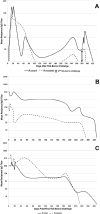Effects of homologous and heterologous immunization on the reservoir competence of domestic dogs for Rickettsia conorii (israelensis)
- PMID: 24201056
- PMCID: PMC5659121
- DOI: 10.1016/j.ttbdis.2013.07.010
Effects of homologous and heterologous immunization on the reservoir competence of domestic dogs for Rickettsia conorii (israelensis)
Abstract
A number of spotted fever group (SFG) rickettsiae cause serious infections in humans. Several antigenically related rickettsial agents may coexist within the same geographical area, and humans or vertebrate hosts may be sequentially exposed to multiple SFG agents. We assessed whether exposure of a vertebrate reservoir to one SFG Rickettsia will affect the host's immune response to a related pathogen and the efficiency of transmission to uninfected ticks. Two pairs of dogs were each infected with either Rickettsia massiliae or Rickettsia conorii israelensis, and their immune response was monitored twice weekly by IFA. The four immunized dogs and a pair of naïve dogs were each challenged with R. conorii israelensis-infected Rhipicephalus sanguineus nymphs. Uninfected Rh. sanguineus larvae were acquisition-fed on the dogs on days 1, 7, and 14 post-challenge. These ticks were tested for the presence of rickettsial DNA after molting to the nymphal stage. The naive dogs became infected with R. conorii israelensis and were infectious to ticks for at least 3 weeks, whereas reservoir competence of dogs previously infected with either R. massiliae or R. conorii was significantly diminished. This opens an opportunity for decreasing the efficiency of transmission and propagation of pathogenic Rickettsia in natural foci by immunizing the primary hosts with closely related nonpathogenic SFG bacteria. However, neither homologous immunization nor cross-immunization significantly affected the efficiency of R. conorii transmission between cofeeding infected nymphs and uninfected larvae. At high densities of ticks, the efficiency of cofeeding transmission may be sufficient for yearly amplification and persistent circulation of a rickettsial pathogen in the vector population.
Keywords: Horizontal transmission; Immunization; Reservoir competence; Rhipicephalus sanguineus; Rickettsia conorii.
Published by Elsevier GmbH.
Figures



Similar articles
-
Domestic dogs (Canis familiaris) as reservoir hosts for Rickettsia conorii.Vector Borne Zoonotic Dis. 2012 Jan;12(1):28-33. doi: 10.1089/vbz.2011.0684. Epub 2011 Sep 16. Vector Borne Zoonotic Dis. 2012. PMID: 21923270
-
Incongruent effects of two isolates of Rickettsia conorii on the survival of Rhipicephalus sanguineus ticks.Exp Appl Acarol. 2009 Dec;49(4):347-59. doi: 10.1007/s10493-009-9268-9. Epub 2009 May 7. Exp Appl Acarol. 2009. PMID: 19421877
-
Co-feeding as a route for transmission of Rickettsia conorii israelensis between Rhipicephalus sanguineus ticks.Exp Appl Acarol. 2010 Dec;52(4):383-92. doi: 10.1007/s10493-010-9375-7. Epub 2010 Jun 30. Exp Appl Acarol. 2010. PMID: 20589416
-
Mediterranean spotted fever.Infect Dis Clin North Am. 2008 Sep;22(3):515-30, ix. doi: 10.1016/j.idc.2008.03.003. Infect Dis Clin North Am. 2008. PMID: 18755388 Review.
-
[Emerging rickettsioses].Parassitologia. 2004 Jun;46(1-2):123-6. Parassitologia. 2004. PMID: 15305700 Review. Italian.
Cited by
-
Vector competence of Amblyomma americanum (Acari: Ixodidae) for Rickettsia rickettsii.Ticks Tick Borne Dis. 2017 Jun;8(4):615-622. doi: 10.1016/j.ttbdis.2017.04.006. Epub 2017 Apr 12. Ticks Tick Borne Dis. 2017. PMID: 28433728 Free PMC article.
-
Exploring immunogenicity of tick salivary AV422 protein in persons exposed to ticks: prospects for utilization.Exp Appl Acarol. 2021 Sep;85(1):83-99. doi: 10.1007/s10493-021-00653-z. Epub 2021 Aug 25. Exp Appl Acarol. 2021. PMID: 34432178
-
An Ecological Framework for Modeling the Geography of Disease Transmission.Trends Ecol Evol. 2019 Jul;34(7):655-668. doi: 10.1016/j.tree.2019.03.004. Epub 2019 May 8. Trends Ecol Evol. 2019. PMID: 31078330 Free PMC article. Review.
-
High Prevalence of Tick-Borne Zoonotic Rickettsia slovaca in Ticks from Wild Boars, Northeastern Italy.Animals (Basel). 2022 Apr 8;12(8):967. doi: 10.3390/ani12080967. Animals (Basel). 2022. PMID: 35454214 Free PMC article.
-
Co-Feeding Transmission of the Ehrlichia muris-Like Agent to Mice (Mus musculus).Vector Borne Zoonotic Dis. 2016 Mar;16(3):145-50. doi: 10.1089/vbz.2015.1878. Epub 2016 Jan 29. Vector Borne Zoonotic Dis. 2016. PMID: 26824725 Free PMC article.
References
-
- Badger LF. Rocky Mountain spotted fever and Boutonneuse fever. Study of their immunological relationships. Public Health Rep. 1933;48:507–511.
-
- Bates D, Maechler M, Bolker B. LME4: Linear mixed-effects models using S4 classes, R package version 0.999375-216-42. 2011 http://CRAN.R-project.org/package=lme4.
-
- Beati L, Raoult D. Rickettsia massiliae sp. nov., a new spotted fever group Rickettsia. Int. J. Syst. Bacteriol. 1993;43:839–840. - PubMed
-
- Bechah Y, Mege JL, Raoult D. Cross-protection among Rickettsia species and subspecies in a guinea pig model of cutaneous infection. Comp. Immunol. Microbiol. Infect. Dis. 2012;35:551–556. - PubMed
MeSH terms
Grants and funding
LinkOut - more resources
Full Text Sources
Other Literature Sources

